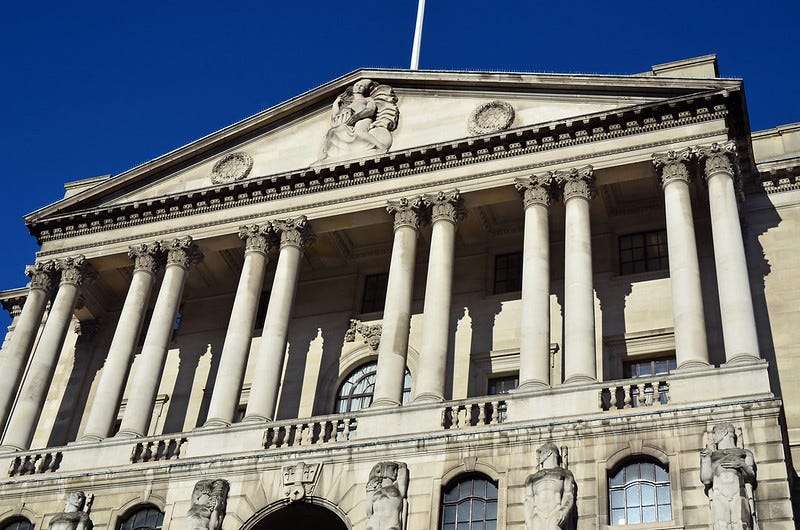10 August 2022. Trucks | Inflation
The tractors and trucks of the futures // Getting it wrong about inflation [#358]
Welcome to Just Two Things, which I try to publish daily, five days a week. Some links may also appear on my blog from time to time. Links to the main articles are in cross-heads as well as the story. A reminder that if you don’t see Just Two Things in your inbox, it might have been routed to your spam filter.
1: The tractors and trucks of the future
My former colleague Andre Furstenberg sent me a terrific link from Dezeen magazine on an Indian design for an electric powered tractor.
Actually, it’s more than a tractor. It’s a ‘Multi-Utility Farming Vehicle’, and it is designed as subscription-based electric tractor which can be fitted out with different add-ons to work as a general purpose harvesting vehicle for rural India.
(Image: © Madha Dev)
Due to the abundance of sunlight in India, the vehicles feature solar panels that provide energy to a mobile electricity reserve, which can be utilised to run farmers' households, as well as serve as a back-up power source. The electric vehicles enable easier maintenance of crops, reduce carbon emissions and facilitate a greater towing capacity.
The designer is Madhav Dua, and we know about the MUFV because it has won the first prize in Dezeen’s Future Mobility Competition.
Dua's design aims to offer Indian farmers more modern tools, which are usually prohibitively expensive, for a more accessible cost in a bid to make farming more efficient. The tractor makes use of plug-and-play technology, which enables it to be configured for a myriad of activities including surface tillage, seeding, baling and other agricultural operations.
It can also be used as a delivery vehicle.
The problem it’s trying to solve is this:
"Agriculture accounts for the livelihood of about 58 per cent of India's population, contributing 18 per cent to the country's GDP annually.
"The supply chain has several logistical, infrastructural and mobility issues. On average, a farmer travels 12km to reach the nearest marketplace, as opposed to the recommended 5km radius, according to the National Farm Commission.
As with much innovation, it’s not just about technology. There’s some business model innovation going on as well, at least in theory. Dua imagines that faming unions might take out the subscriptions on the behalf of their members and share the tractors.
Dua has been working with Arrival, which I have written about here before. Arrival’s business model is about reconfiguring the way in which vehicles are made, moving from a mass production model to a micro-factory model. Due imagines that his tractor could be made in Arrival micro-factories in India’s tier two areas, which tend to be less urban and more rural that the tier-one city regions:
He envisions tier-two regions expanding their delivery of goods to more rural tier-three locations, which would in turn "localise production, increase affordability, avoid overproduction, and be optimised for specific crops and geographical conditions in different regions of India".
There were 170 entries for the mobility competition, but the judges’ decision was unanimous:
"Dua's proposal takes key aspects of Arrival's unique method for designing and producing affordable electric vehicles and suggests how these could be applied to rural India in a way that could have a truly transformative effect on people's daily lives."
It’s also worth mentioning the runners-up since together they tell us something about the way the mobility sector might be going.
In second place, there was a proposal by Unknown Untitled, who imagined
a family of electric autonomous refuse trucks with compact footprints for the narrow streets of Paris... The studio designed a series of refuse vehicles to collect general waste, items for recycling such as glass, cardboard, plastic and bio waste, as well as furniture in a bid to reduce congestion in Paris and improve waste management across the city.
As with the tractor, this design is also modular.
And third place also went to a modular vehicle—this time for emergency vehicles that could be combined to form an emergency hospital.
The concept was designed to reduce pressure on health services such as the NHS, which struggles with congestion, long wait times and lack of hospital beds in cities, while providing faster access and better connectivity in rural or remote areas... When not required for emergency use, the vehicles can also provide core hospital services such as general patient, maternity and paediatric wards.
—
(Image: © Mike George)
The ten finalists can be seen here.
2: Getting it wrong about inflation
One of the things we’ve seen in the current round of inflation is the extent to which central banks and economists are locked into mental models about the economy which, broadly, derive from the 1970s.
But the world has moved on, and the causes of inflation now aren’t the causes of inflation then. But that hasn’t stopped institutions such as the Bank of England behaving as if our present round of inflation is caused by too much demand in the economy—and therefore increasing interest rates to engineer an increase in unemployment.
(The Bank of England: not thinking clearly. Image: Images George Rex/flickr. CC BY-SA 2.0)
In Social Europe Jayati Ghosh looks at some of the recent research into the causes of increasing prices.
The number of economists, and consequently policy-makers, who remain wedded to the unyielding idea that inflation results from too-loose monetary policy—hence central banks should restrict the money supply and raise interest rates—is legion. It has become what JK Galbraith would have called the ‘conventional wisdom’.
It is still wrong. The causes of inflation vary by context and period.
As she says, the notion that ‘unemployment has to increase to control inflation’ has taken a bit of a beating, “conceptually and empirically”, since the turn of the century.
The evidence suggests that we should be looking at a different hypothesis:
Consider only the possibility that the driver of price rises is not ‘excess demand’ or workers demanding higher wages because they are not being adequately ‘disciplined’ by unemployment, but corporate profiteering, along with financial speculation in commodities markets.
The evidence points this way. In the US, for example, the Economic Policy Institute has found that between the middle of 2020 and the end of 2021,
corporate profits were responsible for 54 per cent of overall inflation—a dramatic increase from the 11 per cent they accounted for in the previous four decades (1979-2019). By contrast, unit labour costs were responsible for less than 8 per cent of the inflation.
Some of this might be an effect from pent up post pandemic demand. But more of it is a function of corporate market power.
Research by the Roosevelt Institute shows that in 2021 firms in the US increased their mark-ups and profits at the fastest annual pace since 1955, taking both to their highest absolute levels since that booming postwar decade.
In other words, these price increases were already accelerating before the Ukraine war, which effectively got used as an alibi for mark-ups:
Massively increased corporate profits were most evident in energy, food and pharmaceuticals, as the supply shortages resulting from the war in Ukraine became convenient excuses for disproportionate price increases.
It turns out that having a competition policy that is driven only by tests of “consumer benefit”, as US anti-trust policy has been since the Reagan era, is bad for consumers and good for corporations.
This isn’t the whole story. There’s also speculation:
Financial speculation, such as in wheat futures, drove up prices even in spot markets and the recent decline in wheat prices similarly reflects changes in futures contracts. (This is typical of speculative bubbles, which while often driven by news also tend to be affected by herd behaviour rather than real-world events.)
If the causes of inflation are market power and speculation rather than excess consumer demand, then obviously that suggests that the policy response should be different:
It should instead focus on regulatory action to curb monopoly power and financial speculation. Taxation of excess profits could be a deterrent to such behaviour in future, but specific actions to control prices of strategic commodities also have a role, as Isabella Weber noted. Those who have pilloried such policies appear to be unaware of both history and wider experience.
Closer to home, the economist Anne Pettifor has made a similar argument, a little more trenchantly, on her Substack newsletter:
Broadcasters could not bring themselves to ask the simple question: are working people really to blame for high inflation? Do high oil, gas and food prices have anything to do with the state of the British economy, its government or the decisions of its central bank?...
Instead, high commodity prices are fixed globally by unregulated speculative players in globalised financial markets. In which case, higher interest rates for the domestic economy could have no short or even medium-term impact on price-setting in speculative markets.
Of course, it’s hard to tell whether this is incompetence or malice. I tend to the view that it’s a form of groupthink—it’s quite likely that the Bank of England’s Monetary Policy Committee simply doesn’t read the sources that Jayati Ghosh references in her piece. And they will simply brush off an economic narrative from a trades union leader—even though his model of the world is closer to the evidence.

The mental models of all groups of elite professionals change slowly. They’re always behind the times. And it’s possible that because economics has been the dominant policy discipline for almost forty years now—framed by a very particular set of worldviews—that the mental models of economists change even more slowly. But that’s not an excuse for impoverishing people.
Update: Degrowth
I mentioned yesterday the challenge that the idea of ‘degrowth’ represented to our deep ideas about how the world is. I was primed, obviously, but to my surprise there was a piece on Reuters by Federica Urso and Mark John which suggests that this might, at last, be changing:
The IPCC's biodiversity counterpart IPBES last month included degrowth among a number of alternative economic models with insights that could help to arrest environmental degradation. "In the plenary, even the word 'degrowth' wasn't challenged. That's very interesting," IPBES report co-chair Unai Pascual told Reuters of conclusions that won approval from 139 member countries, including China, India, Russia and the United States.
The article on degrowth published in June by Davos-organiser the World Economic Forum hinted at degrowth impacts, suggesting "it might mean people in rich countries changing their diets, living in smaller houses and driving and travelling less".
The New York bank Jefferies has even published a note called ‘Degrowth opportunities’—with a discussion of which stocks might benefit. Of course it has.
j2t#358
If you are enjoying Just Two Things, please do send it on to a friend or colleague.





